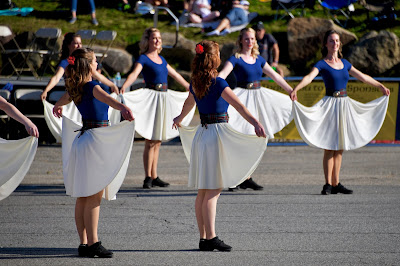Binary isn’t a dirty word among the Scots. Yes, many of the men wear skirts, but it wouldn’t be a good idea to question the masculinity of a kilt-wearing man at the recent Highland Games in Lincoln, New Hampshire. Generally, I hate crowds, but I willingly endured the throng that turned out for the Scottish soiree last Saturday. The first thing I did was visit the exhibit tent of Clan MacLachlan [Gaelic spelling for McLaughlin], the Scottish branch of my ancestors.
 |
| Old Castle Lachlan on Lachlan Bay in the Scottish Highlands |
Gaelic Scotland was settled from northern Ireland. If you stand on the shore of County Antrim in Ulster on a clear day, you can see across the Irish Sea to Scotland. It’s that close. Just to the west of County Antrim is the Inishowen Peninsula where the largest Irish branch of the clan still lives and where my great-grandfather was born. The July/August 2001 edition of Archaeology Magazine explains it this way:
Ireland in the Early Christian period (A.D. 400-1177) was made up of at least 120 chiefdoms, usually described in surviving documents as petty kingdoms, typically having about 700 warriors. One of these petty kingdoms was Dál Riata, which occupied a corner of County Antrim, the island's northeasternmost part. Around A.D. 400, people from Dál Riata began to settle across the Irish Sea along the Scottish coast in County Argyll. Other Irish migrants were also establishing footholds along the coast farther south, as far as Wales and even Cornwall, but the migrants from Dál Riata were especially noteworthy because they were known to the Romans as "Scotti" and they would eventually give their Gaelic language and their name to all of what is now known as Scotland.
There remain Gaelic-speaking areas in Brittany too. They’re all Celtic, the last vestiges of the ancient tribe the Greeks referred to as Keltoi, or “tall ones.” The Romans called them “Gauls” and Julius Caesar said they called themselves “Celts.” Their original language will likely join Latin as a dead language in just a few more generations. The “tall ones” characterization describes many of the men participating in the Highland Games, the events of which involve the lifting and throwing of various heavy and awkward objects including stones and logs. At 6’5” and 300 lbs, the contestants were as big and brawny as NFL linemen, and they were all wearing kilts.
Clan pride is still fierce — kind of an extension of family honor, and leading, I think, to national pride. Each clan has its own “tartan,” a unique plaid fabric with certain interwoven colors, configurations of which are “owned” by the clan and used to sew kilts, hats, and an over-the-shoulder sash such as you’d see watching movies like “Rob Roy” and “Braveheart.” Also unique to each clan is its heraldry displaying elements of clan history and a slogan. For Clan MacLachlan, the slogan is “Fortis et Fidus,” which means “brave and faithful.”
Men wearing kilts at the Highland games had a confident bearing as if they had internalized Rule #1 of Jordan Peterson’s Twelve Rules for Life: An Antidote For Chaos. “Stand up straight, shoulders back.” They looked straight ahead. They made eye contact. They knew who they were. So did the women.
 |
| Isle of Skye Scotland |
Another recent book came to mind as I observed people in the crowd. That would be the just-published Primal Screams by Mary Eberstadt, who claims the sexual revolution and related social upheaval of the sixties in America have “… whittled away at our primary attachments [and] have by now deprived a great many people of traditional answers to the question, ‘Who am I?’ These traditional answers involve our relations to others: I am a sister, mother, aunt, cousin, wife, etc. We define our identities relationally … But for a lot of us today, thanks to family vanishing, those fundamental familial building blocks of identity are harder to come by.”
 |
| Dancers with the RCMP Pipe and Drum Corps in Lincoln |
Spontaneous dancers at Albannach performance
Performances including formal marching pipe and drum bands like one from the Royal Canadian Mounted Police as well as more primal groups like Albannach, which is Gaelic for Scottish. Albannach really got the blood running in the tent where they put on their show. It was quite infectious. At one point they brought a young bagpiper on stage who couldn’t have been more than five years old. He had to stand on a box so the crowd would see him.
 |
| The young bagpiper |







3 comments:
A non-stop squealing baby on a red-eye flight?
An injured cat howling nearby?
Fingernails on a chalkboard?
Long agonized vomiting?
An old guy hawking up phlegm?
I'm trying hard to come up with a worse sound than bagpipes.
Maybe the resonance really is in one's DNA.
IMHO: Bagpipes are fine.
In fact. I have a soft spot for "Scotland The Brave".
It's folks just LEARNING bagpipes that drive up the sales of Scotch.
Kinda' like "Introduction to reed and brass instruments" in grade school.
Now, ME? If I NEVER hear steel drums again.....
Post a Comment